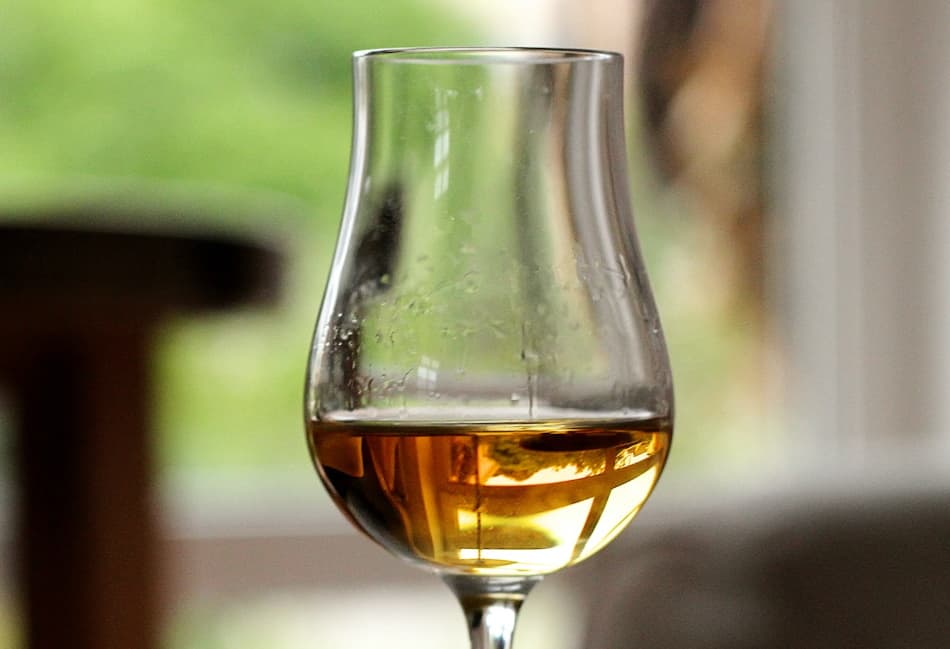You may have seen whiskey drinkers swirl their glass, raise it to the light, and after careful examination make a declaration about its legs. At first, I thought this meant it was time for the drinker to cease activities and go home to bed, but I soon learnt there was more to it than that. So, what exactly are whiskey legs and what do they tell you about your drink.
Whiskey legs are the droplets that stick to the side of the glass after it’s swirled, which form rivulets as they flow back down into the body of the whiskey. Legs can tell you several things about a whiskey, and bigger, slower moving legs means a higher level of alcohol and a greater number of flavors.
In the rest of this article, I’ll explain the exact cause of whiskey legs and go into more detail about what all the different types can tell you about a whiskey. By the end you’ll be able to assess a whiskey’s legs and make specific predictions about the whiskey itself – and sometimes you’ll even be right.

What Causes Whiskey Legs
As mentioned, whiskey legs (also known as whiskey tears or cathedral windows) are the droplets that stick to the side of the glass after the whiskey has been swirled or the glass tilted and then levelled again. The droplets form trails as they flow back into the rest of the whiskey in the glass.
This doesn’t happen with most drinks, but it happens with whiskey because of something called the Gibbs-Marangoni Effect, which describes the interaction between liquids with different rates of evaporation and surface tension (the tendency of molecules of the same type to stick together).
Whiskey is made up of water and alcohol. Water has a higher surface tension than whiskey, but whiskey evaporates faster than water. The following table shows the difference between the surface tension and rate of evaporation of water and alcohol.
| Surface Tension | Rate of Evaporation | |
|---|---|---|
| Water | Higher | Slower |
| Alcohol | Lower | Faster |
Ordinarily, these two parts of whiskey are mixed evenly and so it flows smoothly like any other liquid. However, when part of it comes into contact with air, for example after it’s been swirled in the glass, evaporation will start, and the Gibbs-Marangoni Effect will occur.
Since alcohol evaporates at a faster rate than water, the part of the whiskey that has come into contact with air will become more watery. This means that there will be two versions of the whiskey in your glass. The more alcoholic version in the bowl of the glass and the more watery version on its side.
And since water has a higher surface tension than alcohol, the more watery whiskey on the side of the glass will pull more strongly on the surrounding whiskey than the less watery whiskey in the bowl of the glass. As a result, whiskey will be pulled from the bowl up the sides of the glass, creating droplets which, when they become too heavy, form rivulets as they fall back down into the body of the whiskey.
What Do Whiskey Legs Mean
Now we know what whiskey legs are, the next question is what do they tell you about your whiskey.
Well, according to some people – absolutely nothing.
Others, however, believe that the size and density of the legs and the speed at which they move can indicate several things about the character of your whiskey.

What Bigger, Slower Moving Whiskey Legs Mean
Bigger and therefore, slower moving legs can mean your whiskey has a high level of alcohol. Since the legs are formed when evaporation causes part of your whiskey to become more watery and attract whiskey from the less watery part, the more alcohol it had in the first place the more difference there will be between the two parts and the more whiskey it will attract, making the legs bigger.
Bigger and slower moving whiskey legs can also mean that they contain more extracts from the barrel it was matured in. And since whiskey gets most of its flavors from the barrel, more extracts means that your whiskey will have more flavors, more body and more texture.
And since the longer a whiskey is matured in the barrel, the more extracts and flavors it will pick up from it, bigger and slower moving whiskey legs can indicate an older whiskey.
Finally, bigger and slower moving legs can mean your whiskey is not chill filtered. Many whiskeys are chill filtered to remove fatty acids, esters and proteins that under certain circumstances can undissolve, clump together and make your whiskey cloudy. Some however, prefer non-chill filtered whiskey because they claim that these fatty acids, esters and proteins contain a lot of flavors.
Either way, bigger and slower moving legs can mean your whiskey has not been chill filtered and that it still contains its fatty acids, esters and proteins and therefore, according to some, all its original flavors.
What Smaller, Faster Moving Whiskey Legs Mean
As you may expect, smaller and therefore faster moving whiskey legs means the opposite of bigger and therefore slower moving whiskey legs.
Smaller and faster moving legs can mean that your whiskey has a lower level of alcohol because the evaporation did not create as big a difference between the two parts of your whiskey, and so less whiskey was attracted from one part to the other to form the legs.
Smaller and faster moving whiskey legs can also mean that they contain less extracts from the barrel and that your whiskey will have less flavors, less body and less texture. It can also mean that your whiskey is relatively young.
Finally, smaller and faster moving legs can also mean that your whiskey is chill filtered and that its fatty acids, esters and proteins have been removed along with any flavors they may have had.
The following table summarizes what the different types of whiskey legs can mean.
| Bigger, Faster Moving | Smaller, Slower Moving | |
|---|---|---|
| Alcohol Content | Higher | Lower |
| Flavor | More | Less |
| Body | Fuller | Weaker |
| Texture | Thicker | Thinner |
| Age | Older | Younger |
| Chill-Filtered | No | Yes |
Tip: Assessing a whiskey’s legs is easier when you use a proper whiskey glass, as they’re usually clear and don’t have any patterns that can obscure your view of the whiskey inside. I have written an article about some of the best whiskey glasses out there, which you can find here.
The Limits of Judging Whiskey by its Legs
When it comes to judging a whiskey by its legs a word of caution is necessary.
That’s because, as you’ve probably noticed, there’s a problem with judging a whiskey by its legs which is that each type of whiskey legs can mean one of several things or two of several things or even all of several things. And remember, according to some people they mean none of them.
This shouldn’t put you off trying to judge a whiskey by its legs. As long as you remember that it’s pretty easy to get wrong and that your assessment is only an indication and not a certainty, then you can often tell a lot about a whiskey just from its legs.
